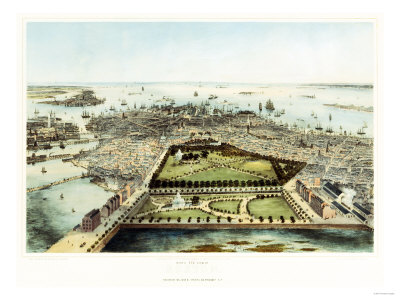Jun 16 2011
Posted by under June 16 Assignment
New York and Boston

By the 1850s, more than half the residents of Boston and New York City were foreign born, and Philadelphia 30 percent of household heads were born in Europe. Major concentration of Irish immigrants cound be found in New York, Boston Philadelphia and San Francisco, and strong German communities emerged in Cincinnati, Louisville, St. Louis and Milwaukee (P.65)
New York and Boston are both city of seaside, they are the fastest growing cities during 18th century, and attract new immigrant from European country, like Irish, German. By 1850s, more than half of the residents of Boston and New York City were born in Europe. The huge number of European immigration makes changes to society, like religion. One of the differences between New York City and Boston is the density in urban side. The Populations of New York grow from 202,589 to 515,500 and Boston growth from 61392 to 136880 in 1830 to 1850. By 1850, there were 135.6 persons per acre in New York, 82.7 in Boston. New York has much higher immigration population and density in urban area than Boston.
Comments Off on New York and Boston











 ave their share of differences and similarities. The most obvious difference is that one is a city from the North while the other is a city from the South. Each has it’s own different lifestyle. With the North being more notable for freedom for slaves and industrial services, the South was none for its intolerance towards slave freedom and their agriculturalist lifestyle. For New Orleans, this wasn’t held completely true. New Orleans “resembled northern counterparts in their commercial functions and social complexity” ( Chudacoff and Smith page 72) Although they were one of the few cities that had commercial functions, the business people relied heavily on the Northern capital and markets. This big one similarity, one difference between New Orleans and New York was that in New York diversity was well known and in a sense accepted. In New Orleans the French speaking people and the English speaking people had to be divided in the city “between a French quarter and an American Quarter, separated by a street with a broad medican called the Neutral Zone” (Chudacoff and Smith page 67) The diverse population in New York was in a sense mixed weren’t living in their own sections as was the case in New Orleans.
ave their share of differences and similarities. The most obvious difference is that one is a city from the North while the other is a city from the South. Each has it’s own different lifestyle. With the North being more notable for freedom for slaves and industrial services, the South was none for its intolerance towards slave freedom and their agriculturalist lifestyle. For New Orleans, this wasn’t held completely true. New Orleans “resembled northern counterparts in their commercial functions and social complexity” ( Chudacoff and Smith page 72) Although they were one of the few cities that had commercial functions, the business people relied heavily on the Northern capital and markets. This big one similarity, one difference between New Orleans and New York was that in New York diversity was well known and in a sense accepted. In New Orleans the French speaking people and the English speaking people had to be divided in the city “between a French quarter and an American Quarter, separated by a street with a broad medican called the Neutral Zone” (Chudacoff and Smith page 67) The diverse population in New York was in a sense mixed weren’t living in their own sections as was the case in New Orleans.










